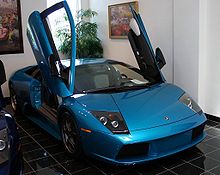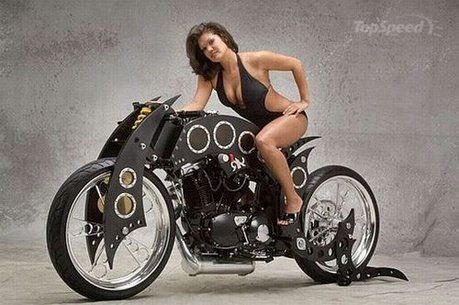The Lamborghini Murciélago (/ˈmɜrsɪərlɑːɡoʊ/) is a high-performance two-door, two-seat sports car that was produced by Italian automaker Lamborghini between 2002 and 2010. Often referred to as a supercar, it was the flagship of the automaker's lineup. The Murciélago was introduced as a coupé in 2001 for the 2002 model year, succeeding the famed Diablo supercar in Lamborghini's lineup. The car was the automaker's first new design in eleven years, as well as the first under the ownership of German automaker Audi. It was styled by Peruvian-born Belgian Luc Donckerwolke, Lamborghini's head of design from 1998 to 2005.
A roadster version of the car was introduced in 2004, followed by the updated LP 640 coupé and roadster and LP 650-4 Roadster. The final variation to wear the Murciélago nameplate was the LP 670-4 SuperVeloce, powered by the largest and final evolution of the historic Lamborghini V12 engine. Production of the Murciélago ended on November 5, 2010, with a total run of 4,099 cars. It's successor the Aventador was released at the 2011 Geneva Motor Show.
 The Murciélago is a four-wheel-drive, mid-engined luxury sportscar. Its square body is especially low-slung, with its roof rising to just under 4 feet above the ground. The super-fast car features scissor doors, which contribute to its exotic image. First-generation Murciélagos, produced between 2001 and 2010, were powered by a Lamborghini V12 which traces its roots back to the company's beginnings in the 1960s. The rear differential is integrated into the engine unit, and the four-wheel drive features a central viscous coupling. Power was sent to the wheels through a six-speed manual. The Murciélago possesses an independent double-wishbone suspension design, and features a combination of carbon-fiber and steel bodywork. The rear spoiler and the air scoops integrated into the car's shoulders are electromechanically activated, and fold out from the body at high speeds to aid aerodynamic performance and provide additional engine cooling, respectively.
The Murciélago is a four-wheel-drive, mid-engined luxury sportscar. Its square body is especially low-slung, with its roof rising to just under 4 feet above the ground. The super-fast car features scissor doors, which contribute to its exotic image. First-generation Murciélagos, produced between 2001 and 2010, were powered by a Lamborghini V12 which traces its roots back to the company's beginnings in the 1960s. The rear differential is integrated into the engine unit, and the four-wheel drive features a central viscous coupling. Power was sent to the wheels through a six-speed manual. The Murciélago possesses an independent double-wishbone suspension design, and features a combination of carbon-fiber and steel bodywork. The rear spoiler and the air scoops integrated into the car's shoulders are electromechanically activated, and fold out from the body at high speeds to aid aerodynamic performance and provide additional engine cooling, respectively.
 The V12 engine in these cars produced just under 580 PS, or pferdestärke (German: horse strength), a unit of power commonly used in Europe. The engine was capable of powering the car to a speed of 60 mph (97 km/h) in 3.8 seconds. The first-generation cars, equipped with the 6.2-litre V12, were produced between 2001 and 2006, and are known simply as Murciélago. Although subsequent versions of the Murciélago were designated with their engine output in PS, the original cars were not designated "LP 580" in line with the later convention.
The V12 engine in these cars produced just under 580 PS, or pferdestärke (German: horse strength), a unit of power commonly used in Europe. The engine was capable of powering the car to a speed of 60 mph (97 km/h) in 3.8 seconds. The first-generation cars, equipped with the 6.2-litre V12, were produced between 2001 and 2006, and are known simply as Murciélago. Although subsequent versions of the Murciélago were designated with their engine output in PS, the original cars were not designated "LP 580" in line with the later convention.
The Murciélago Roadster was introduced in 2004 as a 2005 model. A sign on the windshield header advises the driver not to exceed 100 mph (160 km/h) with the cloth top in place. Designer Donckerwolke cited the B-2 stealth bomber, the Wally 118 WallyPower yacht, and architect Santiago Calatrava's Ciutat de les Arts i les Ciències in Valencia, Spain as his inspiration for the roadster's revised rear pillars and engine cover.
A roadster version of the car was introduced in 2004, followed by the updated LP 640 coupé and roadster and LP 650-4 Roadster. The final variation to wear the Murciélago nameplate was the LP 670-4 SuperVeloce, powered by the largest and final evolution of the historic Lamborghini V12 engine. Production of the Murciélago ended on November 5, 2010, with a total run of 4,099 cars. It's successor the Aventador was released at the 2011 Geneva Motor Show.
First Generation

The 6.2-liter V12 from a first-generation Murciélago

Lamborghini Murciélago 40th Anniversary Edition
The Murciélago Roadster was introduced in 2004 as a 2005 model. A sign on the windshield header advises the driver not to exceed 100 mph (160 km/h) with the cloth top in place. Designer Donckerwolke cited the B-2 stealth bomber, the Wally 118 WallyPower yacht, and architect Santiago Calatrava's Ciutat de les Arts i les Ciències in Valencia, Spain as his inspiration for the roadster's revised rear pillars and engine cover.
 | ||||||||||
| Manufacturer | Lamborghini | |||||||||
|---|---|---|---|---|---|---|---|---|---|---|
| Production | 2002 - 2010 4,099 built | |||||||||
| Assembly | Sant'Agata Bolognese, Italy | |||||||||
| Predecessor | Lamborghini Diablo | |||||||||
| Successor | Lamborghini Aventador | |||||||||
| Class | Sports car | |||||||||
| Body style | 2-door coupé or 2-door roadster | |||||||||
| Layout | Mid-engine, four-wheel drive | |||||||||
| Engine | 6.2 L V12 580 PS (427 kW; 572 bhp) 6.5 L V12 640 PS (471 kW; 631 bhp) | |||||||||
| Transmission | 6-speed manual 6-speed E-gear semi-automatic | |||||||||
| Wheelbase | 104.9 in (2,664.5 mm) | |||||||||
| Length | 2002-06: 180.3 in (4,579.6 mm) 2007-present: 181.5 in (4,610.1 mm) | |||||||||
| Width | 2002-06: 80.5 in (2,044.7 mm) 2007-present: 81.0 in (2,057.4 mm) | |||||||||
| Height | 44.7 in (1,135.4 mm) 2007-present Roadster: 44.6 in (1,132.8 mm) | |||||||||
| Curb weight | 1,650 kg (3,638 lb) | |||||||||
| Related | Lamborghini Reventón Lamborghini Miura concept | |||||||||
| Designer | Luc Donckerwolke | |||||||||












0 comments:
Post a Comment